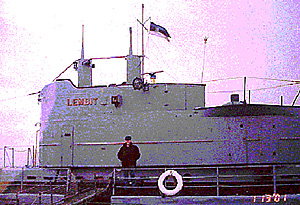 [Picture: Intrepid world-traveler, Major Craig Martelle, USMC, on the Estonian Submarine - Lembit]
[Picture: Intrepid world-traveler, Major Craig Martelle, USMC, on the Estonian Submarine - Lembit]
The best part about Tallinn is obvious from the second we flew into the International Airport - it's not Sheremetevo in Moscow! The airport is bright and efficient. We were through immigration and customs in less than five minutes. The terminal was warm and welcoming. We exchanged $100 at the currency exchange immediately outside the arrivals area - receiving 1610 kroon (pronounced "crown"). The rate in the city was 16.3, with only 14.8 at the hotel. It turned out to be most convenient to exchange money at the airport. We also noted that there was no exchange rate for the Russian Ruble (maybe they no longer want to see them there).
Taxis are just outside and these are the most expensive in the city - a $3.00 taxi ride costs $10.00 with these guys. However, even at $10, it isn't bad - very quick, safe, and an easy delivery. The major hotels have a shuttle service for only 20 kroon each. You may have to wait a little for one to cycle through the airport and the hotels it services.
Estonia, a Baltic country of only one million, 400,000 of whom live in the capital city of Tallinn. Once in the city, public transportation is superb and all of it goes through the center of town. Each trip on a bus or trolleybus (buses that run from overhead electric lines) or tram (on rails that run from overhead electric lines) is only 10 kroon. You can buy these at any kiosk. I ordered ours using the Russian language, but most Estonians understand some English (it is required in the school system) - just speak slowly. Pointing helps, too. We found that almost all Estonians can speak Russian and understand it very well. We had no problems communicating while in the city, though we used Russian exclusively.
Walking Tour of Old Town
Old Town is the heart of the city and has the most character and flavor. It reminded me of Salzburg, Austria (Mozart's birthplace, setting for Sound of Music, etc.) with a little Scandinavian flavor. Very quaint and historic. Some of the buildings were more than 500 years old.
A key feature of Old Town is the battlements. Most older cities in Europe started as forts. Tallinn is no exception. Walls, towers, and historic churches run throughout Old Town. Arches, cobblestone, and narrow streets make up the flavor of the city. I can't say enough how quaint, yet bright and cheery the capital of Estonia is!
Estonia
Peter the Great battled Charles XII of Sweden on Estonian soil. The Battle of Narva was a great defeat for Russia, but not the end of The Great Northern War (1700-1728). Narva is about a four-hour bus ride from Tallinn. We did not have time for this, but it would be a superb tour. Only an hour and a half away by ferry is Helsinki, another city rich in history. The Finns speak English very well and any American traveler will have a good time there.
Museums? Although we did not have the time to visit any, there appears to be some very good ones (shown on the walking map available from your hotel).
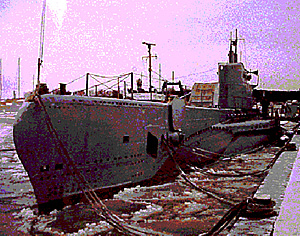 Limpet Submarine
Limpet Submarine
The easiest way to see the Limpet Submarine is to take a Marubo Taksol (Taxi - cheapest and great service) to Olympia Hotel, just outside the city, but right on the Baltic Sea. Look towards the water from the front entrance of the hotel complex and you'll see the sail of the Limpet. This submarine is a true Estonian submarine, built in the 1920's and ended service in 1940.
Originally it was a mine-laying submarine and this accounts for the inordinate amount of open space inside (now that the mines are removed). In the mid 1930's, the submarine was modified to carry and launch torpedoes. The space from the mines made this possible. The launch mechanism and hardware appeared to be Soviet in design and manufacture. It looked like the Limpet would carry four torpedoes in the tubes and another 4 to 6 in the forward compartment (torpedo bay?).
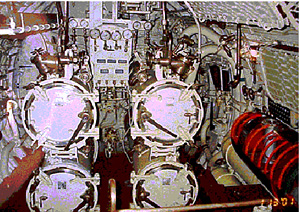 Manned with four officers and 28 petty officers, the ship could stay at sea for 30 days. The galley was right on the bridge, which stood immediately in front of the engine room. Two diesels and two electric engines drove the boat. Surface speed was 12 knots and submerged speed was 8 1/2. This served as no match for the Nazi boats that started WWII with speeds of 17-18 knots on the surface. Behind the engine room was the compressor, which was added during the Soviet refit. Soviet equipment was much larger than the original Estonian so a hole was cut into the deck so the new Soviet compressor would fit.
Manned with four officers and 28 petty officers, the ship could stay at sea for 30 days. The galley was right on the bridge, which stood immediately in front of the engine room. Two diesels and two electric engines drove the boat. Surface speed was 12 knots and submerged speed was 8 1/2. This served as no match for the Nazi boats that started WWII with speeds of 17-18 knots on the surface. Behind the engine room was the compressor, which was added during the Soviet refit. Soviet equipment was much larger than the original Estonian so a hole was cut into the deck so the new Soviet compressor would fit.
All in all, a really scary boat (if you had to go down in it) that I would never have served on. However, the Estonians have preserved it well and made it a great tourist attraction.
Additionally, on the pier beside the submarine was a superb display of naval weapons - torpedoes and mines.
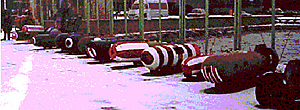 The only drawback for this display is that the signs were in Estonian (kind of like Finnish). In the sail and on the bridge of the Limpet were nice gentlemen who spoke Estonian, Russian, and English in order to provide you with more information and to make your tour more pleasant. Inside the boat were numerous placards and displays, all with English translations provided.
The only drawback for this display is that the signs were in Estonian (kind of like Finnish). In the sail and on the bridge of the Limpet were nice gentlemen who spoke Estonian, Russian, and English in order to provide you with more information and to make your tour more pleasant. Inside the boat were numerous placards and displays, all with English translations provided.
On an important safety note: do not attempt to use the submarine's one toilet - it is all original and really foul to look at, even in its cleaned-up state.
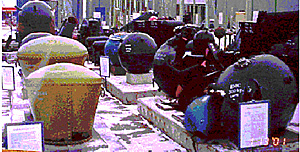 If you have even the slightest chance, take a side trip to Estonia -- Americans do not need a visa if they are just visiting. You can see Tallinn in just a couple days if you are pressed for time. You will not be disappointed.
If you have even the slightest chance, take a side trip to Estonia -- Americans do not need a visa if they are just visiting. You can see Tallinn in just a couple days if you are pressed for time. You will not be disappointed.
Back to The Gauntlet List of Issues
Back to Master Magazine List
© Copyright 2001 by Craig Martelle Publications
This article appears in MagWeb (Magazine Web) on the Internet World Wide Web.
Other military history articles and gaming articles are available at http://www.magweb.com